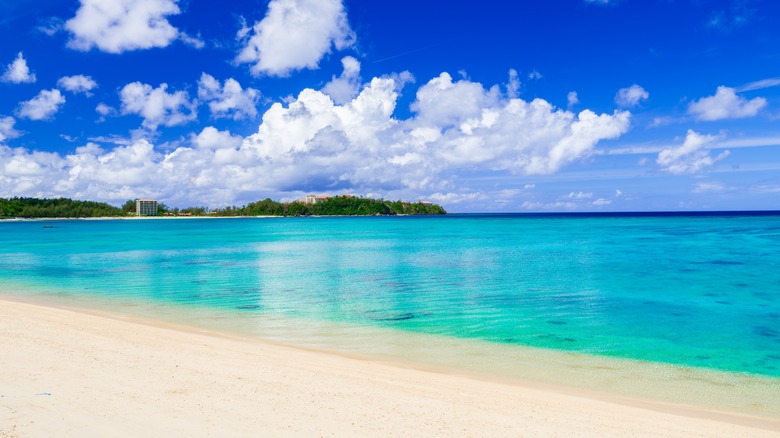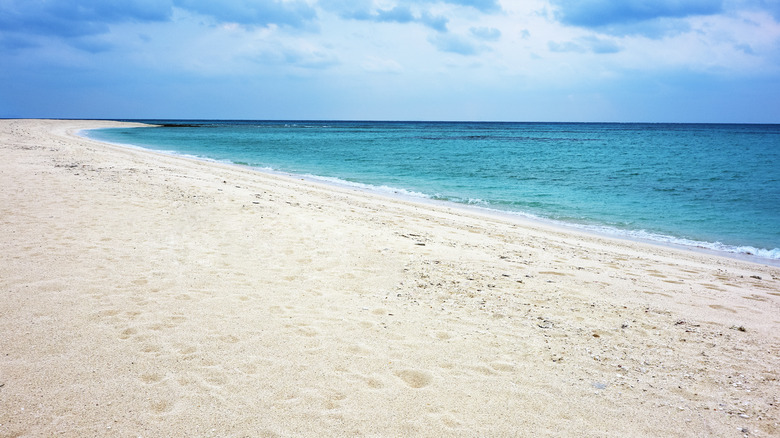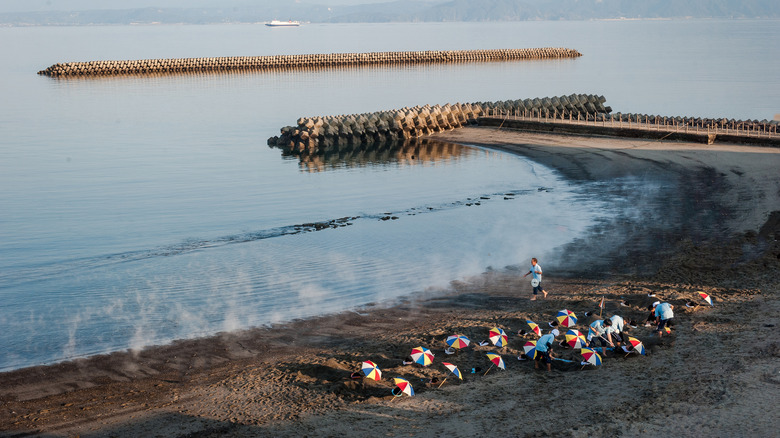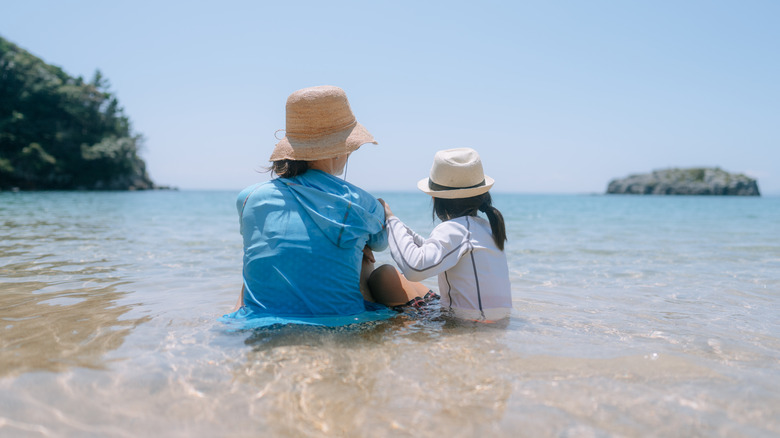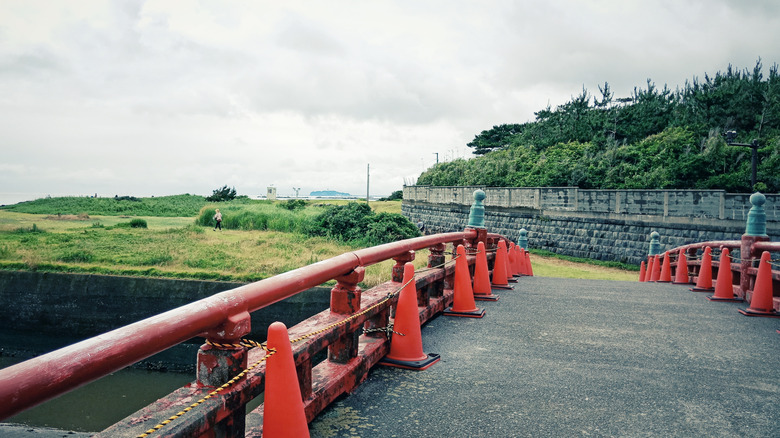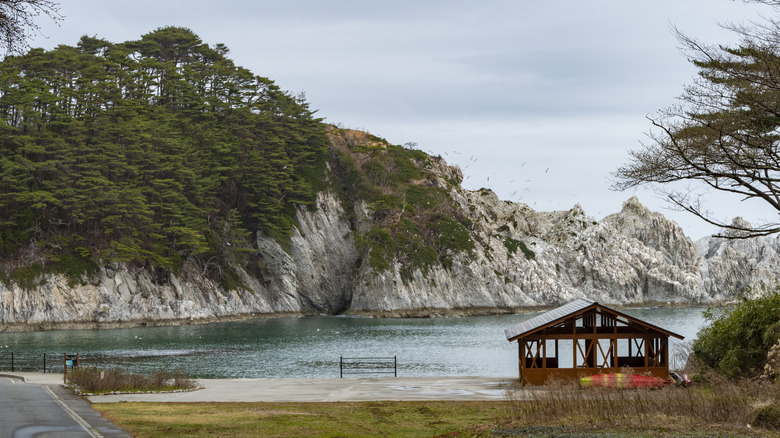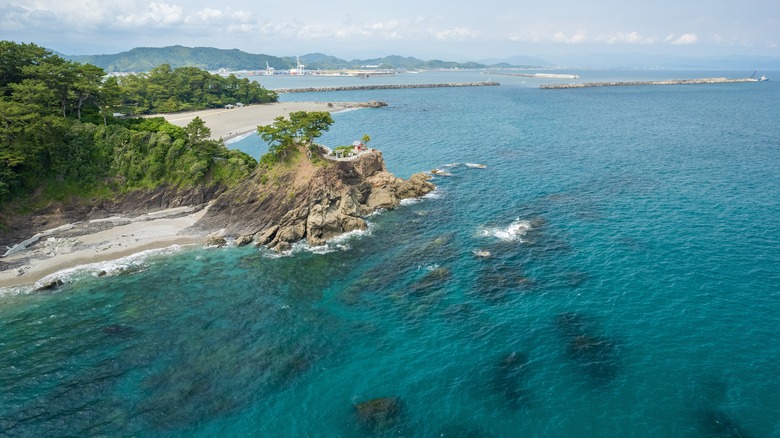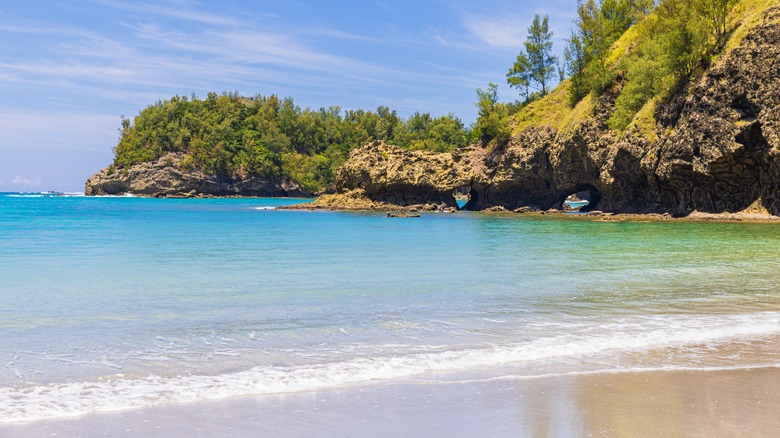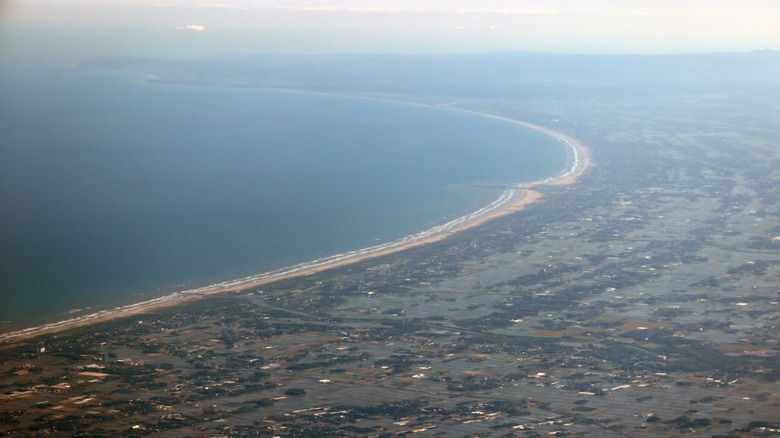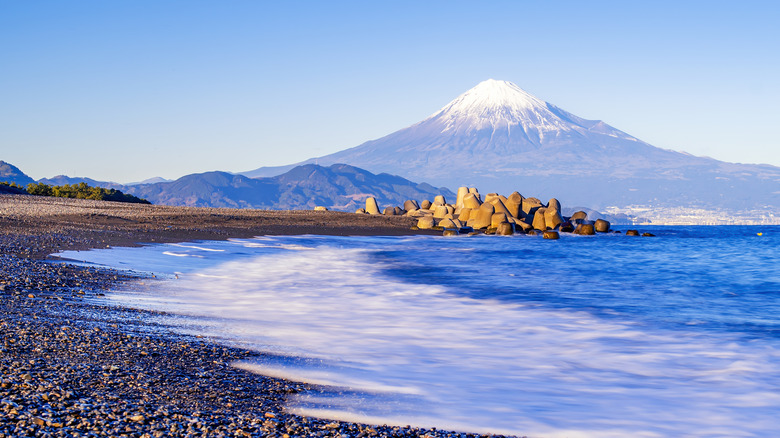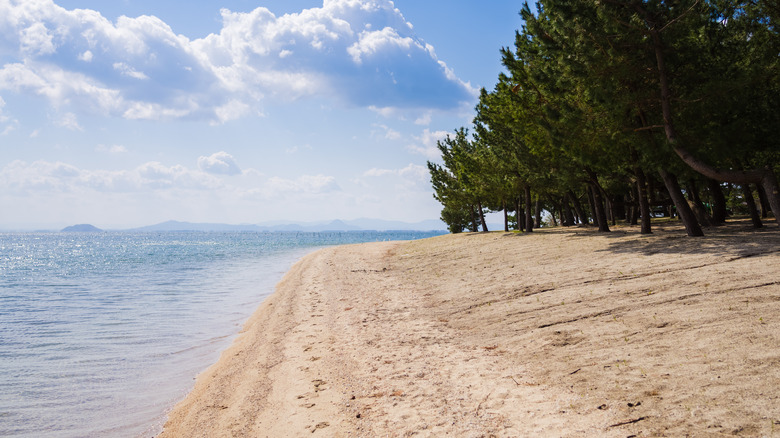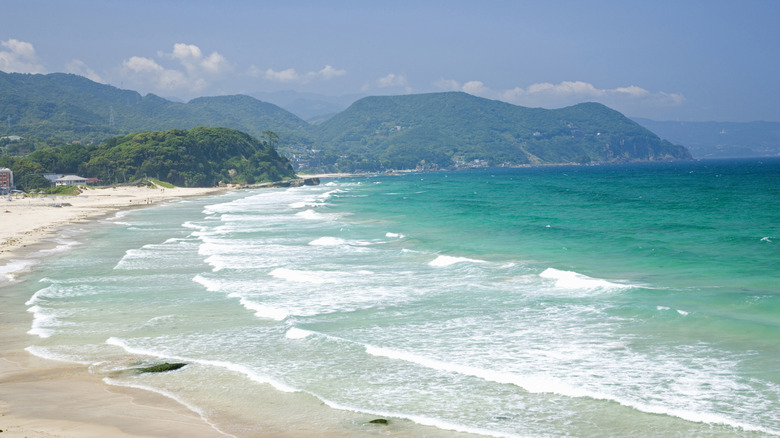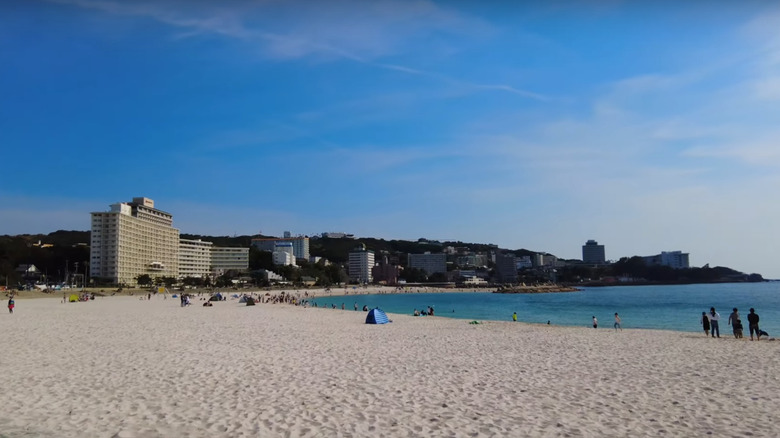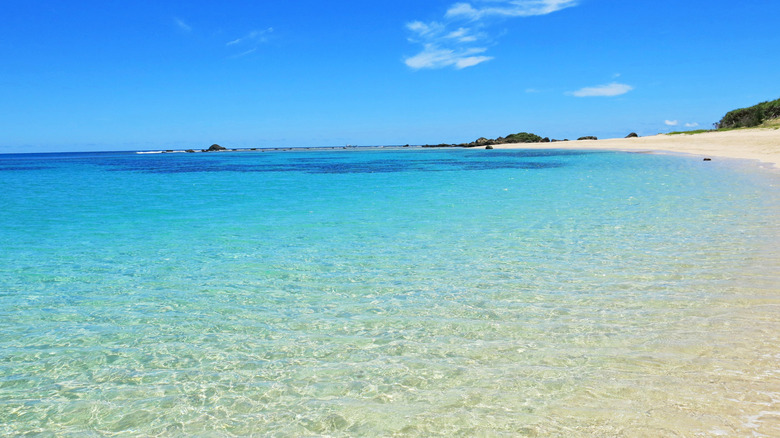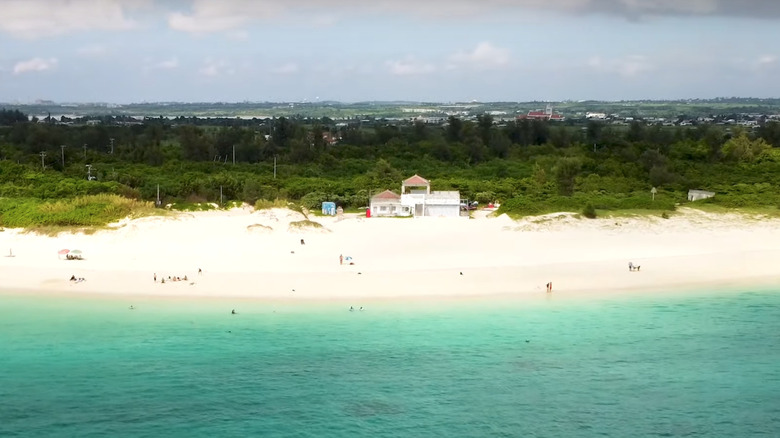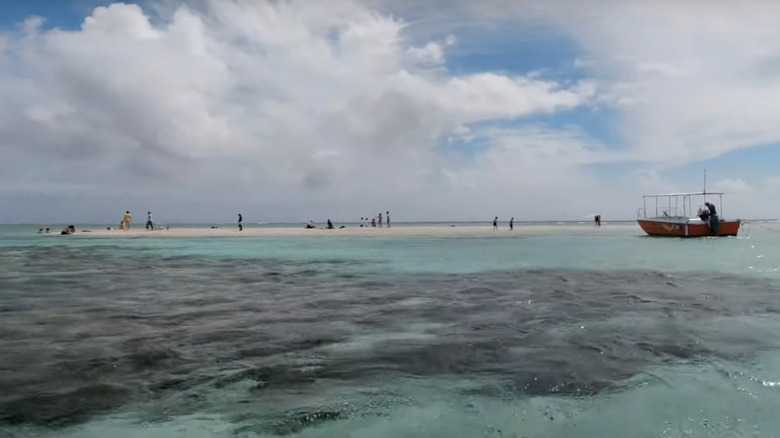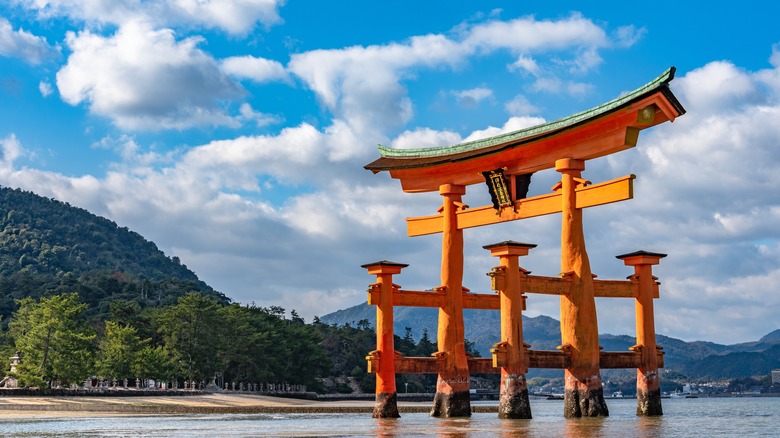The Most Dazzling Beaches Across All Of Japan's Islands, According To Travel Guides
When travelers think of Japan, a country with stunning destinations that won't break the bank, a few images might come to mind. One could be of immaculately landscaped parkland, where vibrant cherry blossoms set the scene ablaze with color. Or perhaps they might picture the frenetic city life of Tokyo, with skyscrapers, throngs of people, banks of neon, and winding alleyways combining to create a buzzing tableau of urban life. Maybe they would imagine a super-fast train hurtling through pristine countryside, a grand temple set behind an austere, minimalist temple gate, or even an iconic mountain frosted in snow. But the thought of Japanese beaches might not be an automatic choice.
And yet, this country of islands — more than 6,500 of them — is packed with beaches, strung along the nation's 34,000 kilometers (or 21,000 miles) of coastline. The islands of Japan are surrounded by the North Pacific Ocean, the Sea of Japan, the East China Sea, and the Philippine Sea. Variety is a hallmark of their existence, from cooler islands in the north near Russia, to semi-tropical ones that sit close to Taiwan, a country full of hidden hot springs. Scouring websites like Japan Guide and forums like Reddit, we've found the best of them. A note to readers, the word "hama" is Japanese for beach, and each beach's location shows the prefecture, or geographic district in the country, where it is situated.
Hateno-hama, Okinawa
Kume Island, in the Okinawa Prefecture, has several great beaches where visitors can swim and snorkel. These include Eef Beach on the east coast and the sunset-primed Shinri-hama. But perhaps the real jewel around Kume is Hateno-hama. This slender, sinewy sandbar off Kume's east coast has brilliant white grains of sand and feels deliciously remote, partly because visitors will need to take a boat to get there.
And the name, Hateno-hama, only adds to the mystique, as it means "beach at the end of the world." "It is probably the most beautiful sea and beach in Japan," says a Google contributor. While lounging on the beach is a treat, travelers can snorkel just offshore and look for manta rays in the nearby reefs. The sandbar is also surprisingly long, stretching for about four miles and divided into three parts.
Ibusuki Beach, Kagoshima
Travelers don't come here to gaze at expanses of sea that are the color of the water in the Caribbean — turquoise and irresistibly hypnotic. What they do find seductive, however, is to immerse themselves in the sand, because it is thermally heated by springs, warmed to temperatures above 120 degrees Fahrenheit. Wander along the certain sections of the beach, which butts against Kagoshima Bay, and you will spy travelers almost entirely covered in black sand, only their heads poking out from the grains as their torsos therapeutically cook.
It might sound frightening, but it's not, as this Google commenter notes. "There is no need to worry even if it is your first experience. The temperature of the sand bath is just right and it is very comfortable. You can hear the sound of the waves and you are in a happy mood."
Iki Island, Nagasaki
Northwest of Fukuoka, Japan's friendliest city, and filled with immaculate food, Iki Island sits moored in the Tsushima Strait, vaguely shaped like a pine cone. Getting to the island gives visitors two choices — a flight from Nagasaki or a ferry from Fukuoka, with high-speed and slow-boat options. Once there, travelers will have their fill of beaches, with more than 30 of them dotted around the island's jagged coastline. Whichever you choose, you can expect to enjoy white sand and clear blue seas, bringing a slice of tropical wonder to the vacation experience.
Among them is Tsutsuki-hama, which impressed this Google commenter. "It is a beautiful sandy beach with the feel of a private beach." This is one of the most popular beaches on this island, close to the airport, and where tourists can come to lounge on the sand or try out some water sports. Also by the airport is Nishiki-hama, where the sand has a pink tinge from pieces of eroded shells, and a bar lets adults savor a libation while gazing over the turquoise shallows.
Isshiki Beach, Kanagawa
This beach is actually two crescents of sand, separated by a compact nub of grassy land, the pair connected by a bridge with bright red rails. Visitors will find plenty of activity at Isshiki Beach, which sits a short distance southwest of Yokohama. This is a fine spot for families, as this Tripadvisor contributor notes. "The waves are very gentle and the sand is very clean. I think it's a great beach for small children to play."
But the beach also attracts windsurfers, kayakers, stand-up paddle-boarders, and adults without kids who want to relish the long sweep of sand or admire the grand, red torii gate set atop rocks by the waterfront. For some visitors, the beach is extra appealing thanks to the presence of an imperial villa located just inland from the sand, a continuation of a trend that saw royalty build villas in the area during the 12th to 14th centuries.
Jodoga-hama, Iwate
Located within Sanriku Fukko National Park, this beach has some cool, craggy rock spires just offshore. It's a scene that wows this Tripadvisor commenter. "Jodoga-hama is lined with sharp, white rhyolite, and the contrast between the green of the pine trees, the white of the rocks, and the blue of the sea and sky made it feel like a spectacular view representative of Iwate." The name of this destination translates to "paradise" or "pure land" beach, and there is certainly a sense of otherworldly tranquility there.
The beach sits within an inlet, which saves it from surging waves or roiling surf. Travelers are advised to bring water shoes, since this is not a sandy beach; smooth pebbles blanket the shore before yielding to clear blue-green waters. There are also some fine hiking trails near the beach, and a tower that promises striking coastal views.
Katsura-hama, Kochi
This curling beach sits close to an aquarium and features pine trees that add a splash of verdant relief. "There is a promenade along the beach, making it easy to stroll. A very beautiful coastline. You'll want to gaze at it forever," relays a Tripadvisor contributor. This is not necessarily a beach that is primed for swimming, due to the prevalence of powerful coastal currents and the crushing waves that roll into the shore.
But the beach is a great spot for a relaxing ramble, and draws visitors from all over the country for its views of the moon, something they have gone there to see for centuries. Another lure of this destination is the statue of Sakamato Ryoma, a local samurai hero who was born in this area in the 1800s. The statue sits atop a tall stone column, amid the pine trees, and surveys the sands of the beach. Travelers can learn more about him at the nearby Sakamoto Ryoma Memorial Museum, which recreates his family home.
Kominato Beach, Tokyo
The remote Ogasawara Islands sit more than 600 miles south of Tokyo —a city with architect-designed public toilets —and are a UNESCO World Heritage site. These 30 islands house many rare flora and fauna, like the Bonin flying fox, and almost 200 endangered bird species. They are also frequented by dolphins and whales at certain times of the year. What the islands also promise are spectacular beaches, like Kominato Beach, on Chichijima Island, one of the two inhabited islands in the archipelago. The beach features soft white sands, clear blue seas, and in the summer, turtles lay eggs there. This is also a popular spot for hermit crabs.
Nights, when there is no light pollution, are equally alluring at the beach, with the Milky Way visible way up above. Getting to the islands requires some serious commitment, with the ferry ride from Tokyo's Takeshiba Terminal lasting 24 hours. But as this traveler commented about Kominato Beach on Google, the rewards are obvious. "The waves are calm and there are almost no people. It's a ridiculously beautiful beach. At the rocky area on the right, you can see a variety of fish with a snorkel."
Kujukuri Beach, Chiba
"I think this is a place you should visit at least once if you are in Japan," declares a contributor on Google. This might be on account of the sheer length of this beach, which seems to go on forever. Kujukuri Beach is actually vast, 66 kilometers in length, an anomaly in a country where the coastline is more notable for its endless bays and rocky headlands rather than long sweeping sections of sand.
The beach sits east of Tokyo, and visitors might even fly over it before landing at Japan's capital. Kujukuri's name is appropriate, translating to 99 "ri", a measure used to denote distance (about 600 meters for one "ri"). In addition to letting visitors undertake hours-long beach walks in one direction, this is a great destination for surfing, flying a kite, and relaxing on a bright day. Thanks to currents that come up from the south, the water also remains warm enough to swim in until November.
Miho Beach, Shizuoka
Miho no Matsubara refers to an area of great physical beauty, a forest where pine trees blanket a section of the coastline. It's also one of the best places to see Mount Fuji in the winter, and home to this curving beach. To say the views of the iconic mountain from Miho Beach are breathtaking might be an understatement.
A Google commenter was glowing in their take on the vista. "It was a place where you could really enjoy the snow-covered Mt. Fuji. It's amazing that this view is right from the parking lot," they continued, referring to a photo accompanying the review, showing Fuji's unmistakable frosted peak. The beach extends for a few miles, and there are more than 30,000 pine trees along its flank. The combination of components, from the white of Fuji's cone, to the green expanse of pines, to the frothing surf edging the blues of the water, makes this a scene worthy of a timeless landscape painting.
Omi Maiko Beach, Shiga
"The water is so clean and if you go early in the morning, you can welcome sunrise!" beams a reviewer on Google (though they also warn of occasional thefts there). An inviting strip of white-sand beach unfurls along the edge of Lake Biwa, a short hop northeast of Kyoto. There are many reasons to frequent this beach, which extends for a couple of miles along the lakefront.
For starters, swimmers won't have to contend with a salty taste in their mouths after going for a dip in the clear water. And the handsome stock of pine trees along the shore is adept at providing visitors with shade. The lake itself is huge, the largest freshwater lake in the country, and presents travelers with more than 230 kilometers of shore. In addition to being a fine base for swimming, Omi Maiko Beach is a popular spot for windsurfing.
Shira-hama, Shizuoka
When arriving at this beach on a broad peninsula, it might be a good idea to have sunglasses handy. That's because the name Shira-hama translates to "white beach," a nod to the brilliant, dazzling sands found there. Its location places it close to public transport, as this Tripadvisor commenter notes. "This is a stunning beach which was about 10 minutes drive from Shimoda station. We enjoyed a paddle and there were a lot of swimmers."
During summer, this is a well-visited slice of waterfront, a broad, sandy stretch that cedes to tranquil, clear waters. The views of mountains at the end of the beach add a bit of vertical heft to the landscape. Travelers can make an extended stay out of their visit, with plenty of hotels and inns nearby. For a slightly quieter scene, Shira-hama Chuo is at the northern end of the Shira-hama, and is much less trafficked, though with equally inviting turquoise water.
Shirara-hama, Wakayama
For travelers who want to imagine that they are in Hawaii while visiting Japan, lying on the sands of Shirara-hama might do the trick. "The contrast between the blue ocean and the white beach is beautiful. The beach is quite long and the curve is just right. It's not a complete lie to say it's 'like Waikiki,'" notes a Tripadvisor contributor. Some online commentators go so far as to call it a sister beach to Waikiki in Honolulu, and take one look at Shirara-hama, and the comparison is understandable.
The blindingly white sand, which was imported from Australia, forms an inviting curve along the coast, and around it, hotels dot the background. The swimming season here is on the early side, usually beginning in early May, and when it opens, it signifies that the country's beach season has officially started. Another summer treat is the provision of daily fireworks displays, with huge shows on July 30 and August 10 each year. On those dates, more than 3,000 fireworks bring wild light and color to the night sky, and endless joy to scores of vacationers.
Tomori Beach, Kagoshima
What can travelers expect at this beach that is great for families with young kids? According to a Tripadvisor reviewer, "Emerald green sea and white sand. On a clear day, it's perfect for Instagram. When you step onto the beach, you'll be captivated by its clarity." Located on the island of Amami-Oshima, between Taiwan and the main islands of Japan, Tomori Beach sits on the east fringes of that isle. It's a short drive to the beach from Amami Airport, and once visitors lay their eyes on the sand and sea, they must be tempted to never leave.
This beach has been nicknamed Blue Angel, with the greens and blues of the water appearing almost heavenly. The waters are shallow, and with gentle ripples of waves languidly yawning their way to the shore, this is an ideal getaway for youngsters. The lucid qualities of the water can be partly explained by the island's location — it lies within the Amami Gunto National Park.
Yonaha Mae-hama, Okinawa
This beach on Okinawa's Miyako island looks like it's been lifted right from a romantic destination in the Indian Ocean with sensational beach villas. "It's truly paradise," opines a Google commenter. "Water is at Maldives level." Yonaha Mae-hama spreads across a stretch on the southwest of the island, and since it also faces west, it is a great location for taking in the sunset.
The beach checks all the boxes of a fantasy tropical idyll. There is a broad wedge of soft white sand, behind which lush green bushes fan out along the coast. In the distance, forested headlands jut out to break up the flatness of the horizon. And right in front of the shoreline, the crystal clear, turquoise water is calm and undeniably inviting. The beach is about four miles long and is one of the main draws to the island, pulling in visitors from spring through fall. Japan's yearly Strongman triathlon event uses this beach for the swimming segment of the race.
Yuriga-hama, Kagoshima
The thing about Yuriga-hama is that it is the kind of place that is easy to miss. The beach is actually a sandbar, located about a mile off the coast of Yoron Island. This island is far south in Japan's jigsaw of land masses, close to Okinawa's main island, and the water is a mesmerizing shade. Note this comment from a Tripadvisor contributor. "There are not many beaches in Japan where you can see the vivid colors of the shallows over such a wide area." A reviewer on Google fawns, "This is the most beautiful blue in the ocean I have ever seen." The tides dictate when Yuriga-hama forms, but generally it can be seen from spring through fall.
Due to the capricious behavior of the currents, the sandbar shifts positions from day to day, and only emerges for a few hours each time. The sand, however, is reliably soft, fine, and white, and the water assuredly clear, so snorkeling is wondrous. Visitors might even see turtles when paddling in the shallows. Boat trips usually depart from Okaneku Beach, the nearest beach on Yoron Island.
Methodology
Finding the best beaches in Japan was no easy task, since there are so many of them. We used information for country-specific sites, like Japan Guide, and Rakuten, a huge conglomerate that is headquartered in Tokyo. Celebrity Cruises, which has a number of ports on the coast of Japan, was also an informative source for some of the country's beach highlights. The forum Reddit helped provide choices from travelers who had visited the nation, and combining all these threads, we strived to include beaches that recurred throughout our sources.
It was also important to assemble a spread across different regions of the country, wherever possible, rather than just list a bunch of beaches in Okinawa, an archipelago known for its tropical climes. And for every beach that we ended up focusing on, we added a review from Tripadvisor or Google from an actual visitor. That way, when you visit, you can know what to expect.
